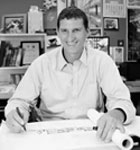 When Clark Nexsen was hired along with Whiting-Turner Contracting Company to design and build the Warrior Transition Unit at the Walter Reed National Naval Medical Center (NNMC), director of architecture David Keith knew the job would be the most significant of his career to date. The facility is designed to be the first place significantly injured men and women come upon as they return home from the battlefield.
When Clark Nexsen was hired along with Whiting-Turner Contracting Company to design and build the Warrior Transition Unit at the Walter Reed National Naval Medical Center (NNMC), director of architecture David Keith knew the job would be the most significant of his career to date. The facility is designed to be the first place significantly injured men and women come upon as they return home from the battlefield.
Here, the architect explains how the project unfolded.
.
This was the most important project we’ve ever worked on. That’s not just because of its importance to our firm or the nationwide support for the program, but because of the number of people it touches and the manner in which it touches them. Everyone wants to do the right thing at the highest level for the warriors who come through this place, and every day our team thought of it in that way. It was an honor just to be a part of it.
The first building, called Building 62, is a new 300,000-square-foot, 9-story building that provides housing for wounded warriors while they are receiving long-term outpatient care. [The structure] includes 153 suites—each with two private bedrooms flanking a common living area with a kitchen and seating area—a dining hall that can serve roughly 300 people at a time, and space for a significant number of therapists. It also contains administrative support offices nestled into a tight [space] adjacent to the new therapy facility—as well as a small daycare facility for use by warriors’ families and NNMC staff. The entry plaza includes a healing garden and outdoor dining area.
Up Close and Personal
What was your first job?
Delivering newspapers on the lawn at the University of Virginia in Charlottesville, VA.
If you weren’t an architect, what would you be?
A baseball coach.
What inspires you?
Working with a lot of passionate professionals, … people who want to do great things.
Describe yourself in three words.
Passionate, creative, and collaborative.
What is your hidden talent?
I am not sure. I think most of my talents are exposed.
The second building, called Building 17, is a 215,000-square-foot physical-fitness center and administrative facility—as well as a parking garage. It includes two collegiate-size gyms, a 50-meter pool, as well as physical- and occupational-therapy and fitness spaces. The program simply required the design-build team to preserve the façade of an existing four-story building originally constructed in 1942—as it was part of the historic fabric of the campus—but our design approach allowed us to save the entire building and add a new complex behind it. An additional hotel is planned for friends and family members who come to stay with the wounded soldiers. That’s important because families help the soldiers with their transition as they learn how to live life after their injuries.
Many sustainable features will be readily apparent to building occupants. Green roofs have been employed on each building, and rainwater will be collected in an underground cistern, treated, and utilized for water closets and urinals, almost entirely relieving the need for potable water for wastewater purposes. Solar collectors for hot water will reduce the amount of energy consumed. Occupants will also notice increased daylight from the building’s ample windows and intelligent massing. We made a decisive effort to enhance the building occupants’ health, comfort, and productivity—attributes that provide particular benefit in a building dedicated to healing.
The project has been designed to be more sustainable than required. The military procurement process didn’t allow for significant interaction about sustainable elements before we were awarded the project. The requirement was for the building to be LEED Silver, but we added a number of things above and beyond that, such as green roofs and solar panels. As a result, we believe the buildings could achieve a higher level [of sustainable certification] than required by the contract.
The beauty of our profession now is that it’s not purely aesthetic. In addition to designing beautiful buildings that work well for the functions within them, we’re being asked to help clients make design decisions that show them actual paybacks. Being knowledgeable enough to say ahead of time that doing this or that can result in significant cost savings is valued more than in the past. And architects, engineers, and contractors have more tools to educate clients about the potential paybacks of sustainable-design decisions. We are selling more than just drawings and specifications; we are adding value by helping clients make good design decisions.

